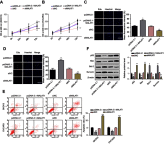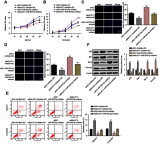LncRNA-MALAT1 regulates proliferation and apoptosis of ovarian cancer cells by targeting miR-503-5p
- PMID: 31496733
- PMCID: PMC6691960
- DOI: 10.2147/OTT.S214689
LncRNA-MALAT1 regulates proliferation and apoptosis of ovarian cancer cells by targeting miR-503-5p
Abstract
Objective: Ovarian cancer (OC) is a common female disease with a poor prognosis. But the possible mechanism of OC tumor progression remains an active area of research. This study is intended to explore the effect of metastasis-associated lung adenocarcinoma transcript 1 (MALAT1) on proliferation and apoptosis of OC and its mechanism.
Materials and methods: MALAT1 and miR-503-5p expressions in human OC cell lines and normal human ovarian epithelial (HOSE) cell line were measured using qRT-PCR. OC cell line SKOV3 is divided into 4 groups: pcDNA3.1 group, pcDNA3.1-MALAT1 group, si-NC group, and si-MALAT1 group. MTT assay and 5-ethynyl-2'-deoxyuridine (EdU) assay were applied for the detection of cell proliferation. Relationship of MALAT1 with miR-503-5p was verified using luciferase assay and RNA pull-down. The luciferase activity in cells was normalized to RNA concentrations determined by Bradford assays.
Results: MALAT1 expression in OC cells was elevated compared with HOSE cells. MTT assay and EdU assay supported that si-MALAT1 could inhibit cell proliferation in OC cells. Treatment of si-MALAT1 results in increased cell apoptosis rate in both SKOV3 cells and OVCAR3 cells. The expression of lncRNA-MALAT1 was negatively associated with the expression of miR-503-5p in OC cells, while luciferase assay and RNA pull-down together supported the direct binding of MALAT1 with miR-503-5p. Knockdown of MALAT1 was able to inhibit the activation of JAK2/STAT3 signal pathway, and MALAT1 overexpression was accompanied by activation of these factors.
Conclusion: lncRNA-MALAT1 can negatively target miR-503-5p expression to further promote proliferation and depress apoptosis of OC cells through the JAK2-STAT3 pathway.
Keywords: JAK2/STAT3; cell apoptosis; cell proliferation; lncRNA-MALAT1; miR-503-5p; ovarian cancer.
Conflict of interest statement
The authors report no conflicts of interest in this work.
Figures





Similar articles
-
LncRNA MALAT1 Regulates the Progression and Cisplatin Resistance of Ovarian Cancer Cells via Modulating miR-1271-5p/E2F5 Axis.Cancer Manag Res. 2020 Oct 12;12:9999-10010. doi: 10.2147/CMAR.S261979. eCollection 2020. Cancer Manag Res. 2020. Retraction in: Cancer Manag Res. 2022 Dec 15;14:3457-3458. doi: 10.2147/CMAR.S401333. PMID: 33116856 Free PMC article. Retracted.
-
LINC-PINT suppresses tumour cell proliferation, migration and invasion through targeting miR-374a-5p in ovarian cancer.Cell Biochem Funct. 2020 Dec;38(8):1089-1099. doi: 10.1002/cbf.3565. Epub 2020 Jul 7. Cell Biochem Funct. 2020. PMID: 32638404
-
Long Non-Coding RNA Metastasis Associated Lung Adenocarcinoma Transcript 1 (MALAT1) Promotes Hypertension by Modulating the Hsa-miR-124-3p/Nuclear Receptor Subfamily 3, Group C, Member 2 (NR3C2) and Hsa-miR-135a-5p/NR3C2 Axis.Med Sci Monit. 2020 Mar 29;26:e920478. doi: 10.12659/MSM.920478. Med Sci Monit. 2020. PMID: 32222724 Free PMC article.
-
Long non-coding RNA MALAT1 regulates proliferation, apoptosis, migration and invasion via miR-374b-5p/SRSF7 axis in non-small cell lung cancer.Eur Rev Med Pharmacol Sci. 2020 Feb;24(4):1853-1862. doi: 10.26355/eurrev_202002_20363. Eur Rev Med Pharmacol Sci. 2020. PMID: 32141554
-
Long non-coding RNA MALAT1 aggravates human retinoblastoma by sponging miR-20b-5p to upregulate STAT3.Pathol Res Pract. 2020 Jun;216(6):152977. doi: 10.1016/j.prp.2020.152977. Epub 2020 Apr 18. Pathol Res Pract. 2020. PMID: 32336590
Cited by
-
HDAC2 enhances esophageal squamous cell carcinoma development through down-regulating microRNA-503-5p and promoting CXCL10.Clin Epigenetics. 2021 Apr 29;13(1):96. doi: 10.1186/s13148-021-01068-8. Clin Epigenetics. 2021. PMID: 33926524 Free PMC article.
-
The Challenges and Opportunities of LncRNAs in Ovarian Cancer Research and Clinical Use.Cancers (Basel). 2020 Apr 21;12(4):1020. doi: 10.3390/cancers12041020. Cancers (Basel). 2020. PMID: 32326249 Free PMC article. Review.
-
The Role of Circular RNA in the Pathogenesis of Chemotherapy-Induced Cardiotoxicity in Cancer Patients: Focus on the Pathogenesis and Future Perspective.Cardiovasc Toxicol. 2024 Nov;24(11):1151-1167. doi: 10.1007/s12012-024-09914-w. Epub 2024 Aug 19. Cardiovasc Toxicol. 2024. PMID: 39158829 Review.
-
Long non-coding RNA MALAT1 facilitates the tumorigenesis, invasion and glycolysis of multiple myeloma via miR-1271-5p/SOX13 axis.J Cancer Res Clin Oncol. 2020 Feb;146(2):367-379. doi: 10.1007/s00432-020-03127-8. Epub 2020 Jan 18. J Cancer Res Clin Oncol. 2020. PMID: 31953613 Free PMC article.
-
Long non-coding RNA PROX1-AS1 knockdown upregulates microRNA-519d-3p to promote chemosensitivity of retinoblastoma cells via targeting SOX2.Cell Cycle. 2021 Oct;20(20):2149-2159. doi: 10.1080/15384101.2021.1971352. Epub 2021 Sep 29. Cell Cycle. 2021. PMID: 34583623 Free PMC article.
References
LinkOut - more resources
Full Text Sources
Miscellaneous

